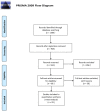Comparisons of GnRH antagonist protocol versus GnRH agonist long protocol in patients with normal ovarian reserve: A systematic review and meta-analysis
- PMID: 28437434
- PMCID: PMC5402978
- DOI: 10.1371/journal.pone.0175985
Comparisons of GnRH antagonist protocol versus GnRH agonist long protocol in patients with normal ovarian reserve: A systematic review and meta-analysis
Abstract
Objective: To evaluate the effectiveness and safety of gonadotropin-releasing hormone antagonist (GnRH-ant) protocol and gonadotropin-releasing hormone agonist (GnRH-a) long protocol in patients with normal ovarian reserve.
Methods: We searched the PubMed (1992-2016), Cochrane Library (1999-2016), Web of Science (1950-2016), Chinese Biomedical Database (CBM, 1979-2016), and China National Knowledge Infrastructure (CNKI, 1994-2016). Any randomized controlled trials (RCTs) that compared GnRH-ant protocol and GnRH-a long protocol in patients with normal ovarian reserve were included, and data were extracted independently by two reviewers. The meta-analysis was performed by Revman 5.3 software.
Results: Twenty-nine RCTs (6399 patients) were included in this meta-analysis. Stimulation days (mean difference (MD) [95% confidence interval (CI)] = -0.8 [-1.36, -0.23], P = 0.006), gonadotrophin (Gn) dosage (MD [95% CI] = -3.52 [-5.56, -1.48], P = 0.0007), estradiol (E2) level on the day of human chorionic gonadotrophin (HCG) administration (MD [95% CI] = -365.49 [-532.93, -198.05], P<0.0001), the number of oocytes retrieved (MD [95% CI] = -1.41 [-1.84, -0.99], P<0.00001), the embryos obtained (MD [95% CI] = -0.99 [-1.38, -0.59], P<0.00001), incidence of ovarian hyperstimulation syndrome (OHSS) (OR [95% CI] = 0.69 [0.57, 0.83], P<0.0001) were statistically significantly lower in GnRH-ant protocol than GnRH-a long protocol. However, the clinical pregnancy rate (OR [95% CI] = 0.90 [0.80, 1.01], P = 0.08), ongoing pregnancy rate (OR [95% CI] = 0.88 [0.77, 1.00], P = 0.05), live birth rate (OR [95% CI] = 0.95 [0.74, 1.09], P = 0.27), miscarriage rate (OR [95% CI] = 0.98 [0.69, 1.40], P = 0.93), and cycle cancellation rate (OR [95% CI] = 0.86 [0.52, 1.44], P = 0.57) showed no significant differences between the two groups.
Conclusion: GnRH-ant protocol substantially decreased the incidence of OHSS without influencing the pregnancy rate and live birth rate compared to GnRH-a long protocol among patients with normal ovarian reserve.
Conflict of interest statement
Figures













Similar articles
-
Risk of severe ovarian hyperstimulation syndrome in GnRH antagonist versus GnRH agonist protocol: RCT including 1050 first IVF/ICSI cycles.Hum Reprod. 2016 Jun;31(6):1253-64. doi: 10.1093/humrep/dew051. Epub 2016 Apr 8. Hum Reprod. 2016. PMID: 27060174 Clinical Trial.
-
Comparisons of GnRH antagonist versus GnRH agonist protocol in supposed normal ovarian responders undergoing IVF: a systematic review and meta-analysis.PLoS One. 2014 Sep 12;9(9):e106854. doi: 10.1371/journal.pone.0106854. eCollection 2014. PLoS One. 2014. PMID: 25216031 Free PMC article.
-
[Comparison of GnRH antagonist fixed protocol and GnRH agonists long protocol in infertile patients with normal ovarian reserve function in their first in vitro fertilization-embryo transfer cycle].Zhonghua Fu Chan Ke Za Zhi. 2012 Apr;47(4):245-9. Zhonghua Fu Chan Ke Za Zhi. 2012. PMID: 22781108 Chinese.
-
GnRH antagonist versus long agonist protocols in IVF: a systematic review and meta-analysis accounting for patient type.Hum Reprod Update. 2017 Sep 1;23(5):560-579. doi: 10.1093/humupd/dmx017. Hum Reprod Update. 2017. PMID: 28903472
-
Effects of gonadotropin-releasing hormone antagonist (GnRH-ant) cessation on trigger day in a GnRH-ant protocol: a meta-analysis.J Obstet Gynaecol. 2025 Dec;45(1):2444496. doi: 10.1080/01443615.2024.2444496. Epub 2024 Dec 28. J Obstet Gynaecol. 2025. PMID: 39731472
Cited by
-
Successful outcome of a pregnancy derived from premature ovulation in a gonadotropin-releasing hormone antagonist protocol: A case report.Clin Case Rep. 2020 Dec 22;9(2):883-886. doi: 10.1002/ccr3.3689. eCollection 2021 Feb. Clin Case Rep. 2020. PMID: 33598265 Free PMC article.
-
Comparative effectiveness of recombinant human follicle-stimulating hormone alfa (r-hFSH-alfa) versus highly purified urinary human menopausal gonadotropin (hMG HP) in assisted reproductive technology (ART) treatments: a non-interventional study in Germany.Reprod Biol Endocrinol. 2021 Jun 16;19(1):90. doi: 10.1186/s12958-021-00768-3. Reprod Biol Endocrinol. 2021. PMID: 34134695 Free PMC article.
-
Clinical pregnancy following GnRH agonist administration in the luteal phase of fresh or frozen assisted reproductive technology (ART) cycles: Systematic review and meta-analysis.Eur J Obstet Gynecol Reprod Biol X. 2019 May 13;3:100046. doi: 10.1016/j.eurox.2019.100046. eCollection 2019 Jul. Eur J Obstet Gynecol Reprod Biol X. 2019. PMID: 31403130 Free PMC article. Review.
-
A matched propensity score study of embryo morphokinetics following gonadotropin-releasing hormone agonist versus human chorionic gonadotropin trigger.J Assist Reprod Genet. 2020 Nov;37(11):2777-2782. doi: 10.1007/s10815-020-01953-w. Epub 2020 Sep 27. J Assist Reprod Genet. 2020. PMID: 32980940 Free PMC article.
-
Fresh or Frozen Embryo Transfer in The Antagonist In Vitro Fertilization Cycles: A Retrospective Cohort Study.Int J Fertil Steril. 2022 Oct 1;16(4):256-262. doi: 10.22074/ijfs.2022.538452.1181. Int J Fertil Steril. 2022. PMID: 36273310 Free PMC article.
References
-
- Fleming R, Adam AH, Barlow DH, Black WP, MacNaughton MC, Coutts JR: A new systematic treatment for infertile women with abnormal hormone profiles. British journal of obstetrics and gynaecology 1982, 89(1):80–83. - PubMed
-
- Porter RN, Smith W, Craft IL, Abdulwahid NA, Jacobs HS: Induction of ovulation for in-vitro fertilisation using buserelin and gonadotropins. Lancet (London, England) 1984, 2(8414):1284–1285. - PubMed
-
- Hughes EG, Fedorkow DM, Daya S, Sagle MA, Van de Koppel P, Collins JA: The routine use of gonadotropin-releasing hormone agonists prior to in vitro fertilization and gamete intrafallopian transfer: a meta-analysis of randomized controlled trials. Fertility and sterility 1992, 58(5):888–896. - PubMed
-
- Forman RG, Frydman R, Egan D, Ross C, Barlow DH: Severe ovarian hyperstimulation syndrome using agonists of gonadotropin-releasing hormone for in vitro fertilization: a European series and a proposal for prevention. Fertility and sterility 1990, 53(3):502–509. - PubMed
-
- Coccia ME, Comparetto C, Bracco GL, Scarselli G: GnRH antagonists. European journal of obstetrics, gynecology, and reproductive biology 2004, 115 Suppl 1:S44–56. - PubMed
Publication types
MeSH terms
Substances
LinkOut - more resources
Full Text Sources
Other Literature Sources

